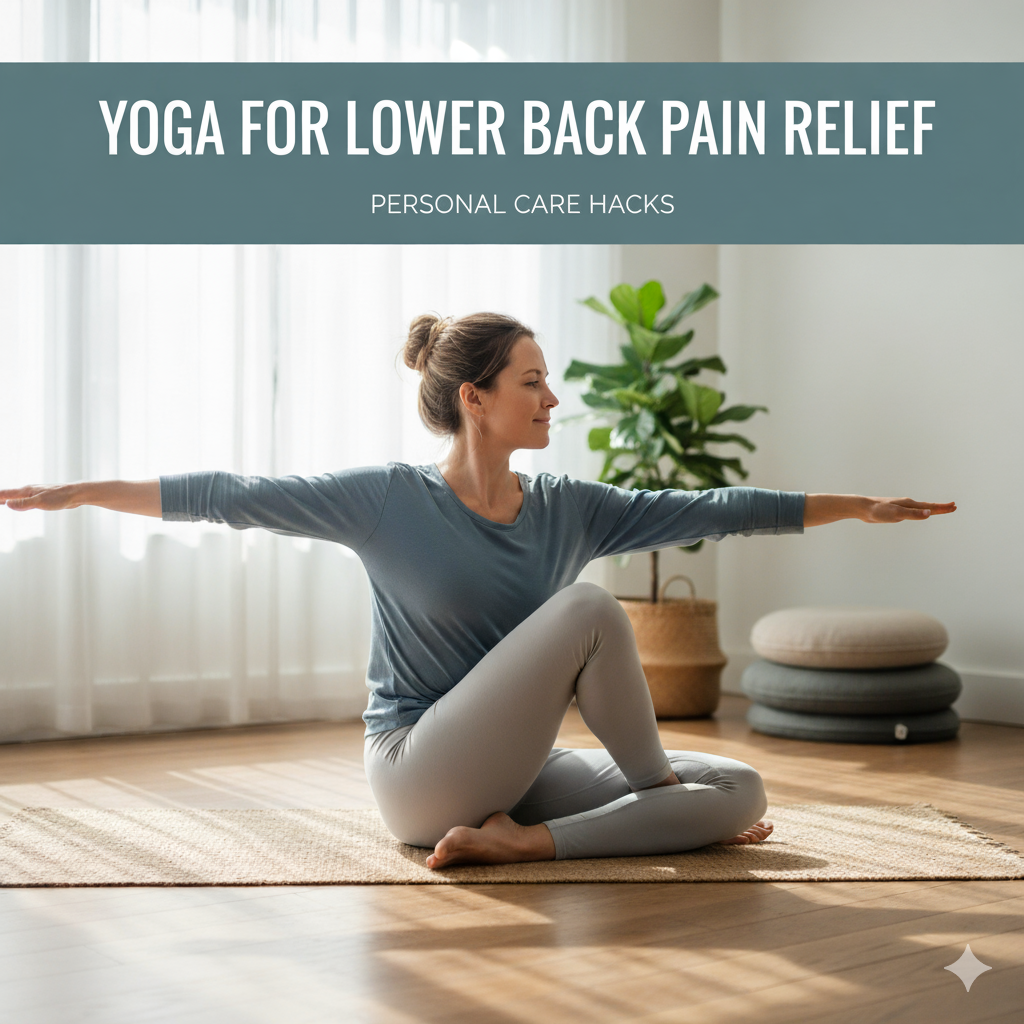Back pain isn’t just a physical ailment; it’s a daily companion that affects your mood, your energy, and your ability to enjoy life. I remember the days when bending down to tie my shoes felt like a monumental task. Sitting at my desk for hours left me stiff and irritable.
But then, I stumbled upon yoga—not as a trendy fitness routine, but as a lifeline for my aching back. If you’re reading this, chances are you’re in a similar boat. You’re tired of popping painkillers and longing for a natural, sustainable solution. Well, you’re not alone, and there is hope.
Yoga, with its gentle stretches and mindful movements, offers a path to relief. In this post, we’ll explore how yoga can alleviate lower back pain, share some effective poses, and even recommend a few products to enhance your practice.
Why Yoga Works for Lower Back Pain and People do Yoga for Lower Back Pain Relief?
Yoga isn’t just about flexibility; it’s about reconnecting with your body. Research supports its effectiveness in managing chronic low back pain. A study published in JAMA Network Open found that a 12-week virtual yoga program significantly reduced pain intensity and improved back-related function in participants JAMA Network. Another study from the Cleveland Clinic highlighted that even a once-weekly online yoga class led to reduced pain and improved sleep and function Cleveland Clinic.
But why does yoga work? It’s because yoga addresses the root causes of back pain—muscle weakness, poor posture, and stress. By strengthening the core, improving flexibility, and promoting relaxation, yoga helps restore balance to the body. It’s not just about stretching; it’s about building resilience.
Essential Yoga Poses for Lower Back Pain Relief
Incorporating specific yoga poses into your routine can make a significant difference. Here are some that have helped me and countless others:
1. Cat-Cow Pose (Marjaryasana-Bitilasana)
This dynamic movement warms up the spine and relieves tension in the back and neck. On hands and knees, inhale as you arch your back (cow), and exhale as you round it (cat). Repeat several times, moving with your breath.
2. Child’s Pose (Balasana)
A restful pose that gently stretches the lower back, hips, and thighs. Kneel on the floor, sit back on your heels, and stretch your arms forward, lowering your forehead to the ground. Hold for 30 seconds to a minute.
3. Downward-Facing Dog (Adho Mukha Svanasana)
This full-body stretch strengthens the back, shoulders, and arms while lengthening the spine. Start on hands and knees, lift your hips towards the ceiling, and straighten your legs, forming an inverted V shape.
4. Bridge Pose (Setu Bandhasana)
Lying on your back with knees bent and feet flat on the floor, lift your hips towards the ceiling, squeezing your glutes and engaging your core. This strengthens the lower back and glutes.
5. Sphinx Pose (Salamba Bhujangasana)
Lying on your stomach, prop yourself up on your forearms, lifting your chest off the ground. This gentle backbend strengthens the spine and relieves lower back tension.
6. Knees to Chest Pose (Apanasana)
Lying on your back, hug your knees towards your chest, gently rocking side to side. This relieves tension in the lower back and massages the spine.
7. Seated Forward Fold (Paschimottanasana)
Sitting with legs extended straight, hinge at your hips to fold forward, reaching for your feet. This stretches the hamstrings and lower back.
8. Pigeon Pose (Eka Pada Rajakapotasana)
A deep hip opener that stretches the glutes and lower back. From a tabletop position, bring one knee forward and extend the opposite leg back, lowering your hips towards the floor.
9. Reclining Spinal Twist (Supta Matsyendrasana)
Lying on your back, draw one knee across your body towards the opposite side, keeping your shoulders grounded. This twist releases tension in the spine and hips.
10. Legs Up the Wall Pose (Viparita Karani)
Lie on your back with your legs extended up a wall, arms relaxed by your sides. This restorative pose promotes circulation and reduces lower back fatigue.
Tips for a Safe and Effective Practice
- Start Slow: Begin with gentle stretches and gradually increase intensity.
- Listen to Your Body: Avoid pushing into pain; discomfort is okay, but pain is not.
- Use Props: Pillows or blankets can provide support and comfort.
- Consistency is Key: Aim for regular practice, even if it’s just 10-15 minutes daily.
- Consult a Professional: If you have a specific injury or condition, seek guidance from a healthcare provider or certified yoga instructor.
Frequently Asked Questions about Yoga for Lower Back Pain Relief
Q: How often should I practice yoga for back pain relief?
A: Practicing yoga 3-4 times a week can be beneficial. Consistency helps build strength and flexibility over time.
Q: Can yoga cure chronic back pain?
A: While yoga may not cure chronic back pain, it can significantly reduce symptoms and improve quality of life.
Q: Are there any risks associated with practicing yoga for back pain?
A: If practiced incorrectly or without proper guidance, yoga can exacerbate back pain. It’s essential to learn poses correctly and listen to your body.
Q: Can I practice yoga if I have a herniated disc?
A: Yes, but modifications are necessary. Consult with a healthcare provider before starting a yoga routine.
Q: Do I need any special equipment to practice yoga?
A: A yoga mat is helpful, but not essential. Props like blocks or straps can assist in certain poses but are not mandatory.
Recommended Products to Enhance Your Practice
To support your yoga journey, here are some products that have been beneficial:
1. Gaiam Essentials Thick Yoga Mat
A durable, non-slip mat providing ample cushioning for comfort during practice.
- Rating: 4.5 stars | 2,000+ reviews
- Price: $29.99
- Pros: Extra thick for joint support, non-slip surface, lightweight, easy to clean, available in various colors
- Cons: May be too thick for balance poses, edges may curl over time, limited color options
- Amazon Review Highlight: “Perfect for my back pain relief practice; the extra cushioning makes a huge difference.”
- Best For: Beginners seeking comfort and support
2. Manduka PRO Yoga Mat
A high-density mat known for its durability and support.
- Rating: 4.7 stars | 5,000+ reviews
- Price: $120.00
- Pros: Lifetime warranty, excellent grip, eco-friendly materials, dense cushioning, available in multiple sizes
- Cons: Heavier than standard mats, higher price point, may require breaking in
- Amazon Review Highlight: “Worth every penny; provides great support for my back during practice.”
- Best For: Regular practitioners looking for a long-lasting mat
3. Gaiam Yoga Blocks
Lightweight foam blocks to assist in achieving proper alignment.
- Rating: 4.6 stars | 1,500+ reviews
- Price: $14.99
- Pros: Lightweight, durable, soft texture, easy to grip, available in various colors
- Cons: May compress over time, not suitable for heavy weight-bearing poses
- Amazon Review Highlight: “These blocks have been a game-changer for my back pain relief routine.”
- Best For: Beginners and those needing extra support in poses
4. PrAna E.C.O Yoga Strap
A durable strap to aid in stretching and flexibility.
- Rating: 4.5 stars | 800+ reviews
- Price: $18.00
- Pros: Adjustable length, eco-friendly materials, sturdy buckle, comfortable to use, compact design
- Cons: Limited color options, may be too long for some users
- Amazon Review Highlight: “Helps me deepen stretches and improve my back flexibility.”
- Best For: Individuals working on flexibility and range of motion
5. YogaAccessories Round Bolster
A supportive bolster for restorative poses and relaxation.
- Rating: 4.8 stars | 1,000+ reviews
- Price: $45.00
- Pros: Firm support, comfortable, removable cover, lightweight, machine washable
- Cons: Larger size may be bulky for storage, higher price point
- Amazon Review Highlight: “Provides excellent support for my lower back during restorative poses.”
- Best For: Those incorporating restorative yoga into their routine
Final Thoughts
Yoga has been a transformative practice in my journey to alleviate lower back pain. It’s not just about the physical postures; it’s about connecting with your body, listening to its signals, and nurturing it with care. Remember, consistency is key, and it’s okay to start slow. Your body will thank you for it.




Leave a Reply